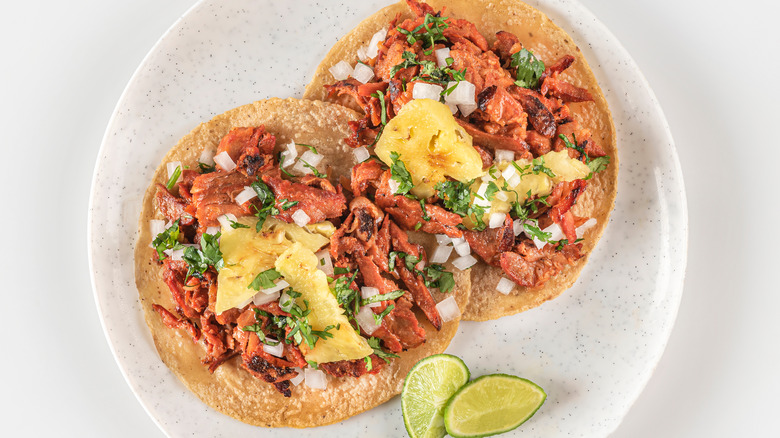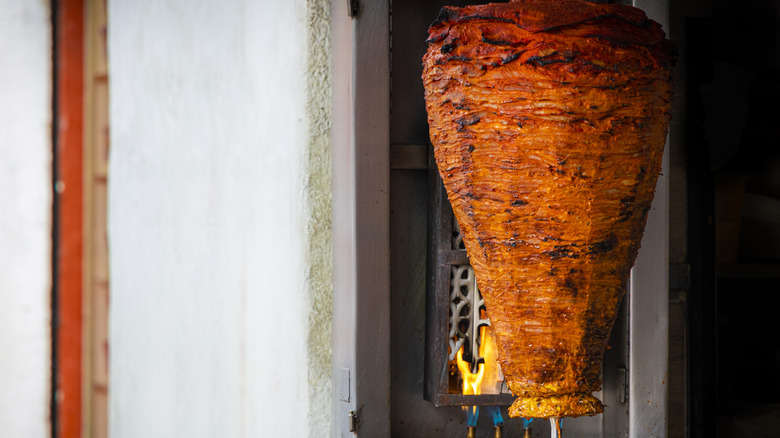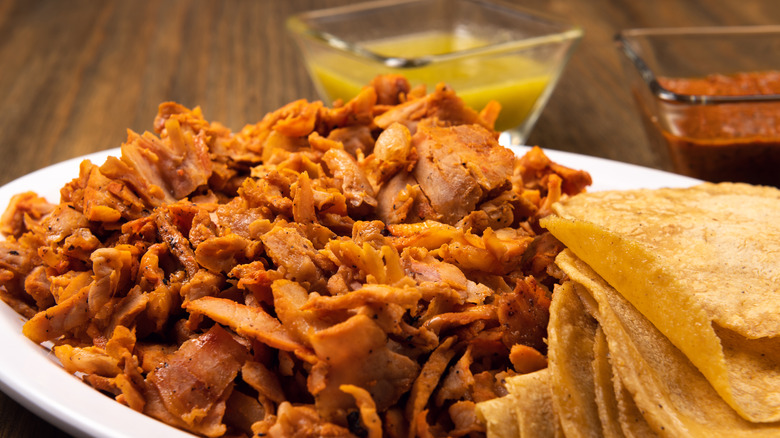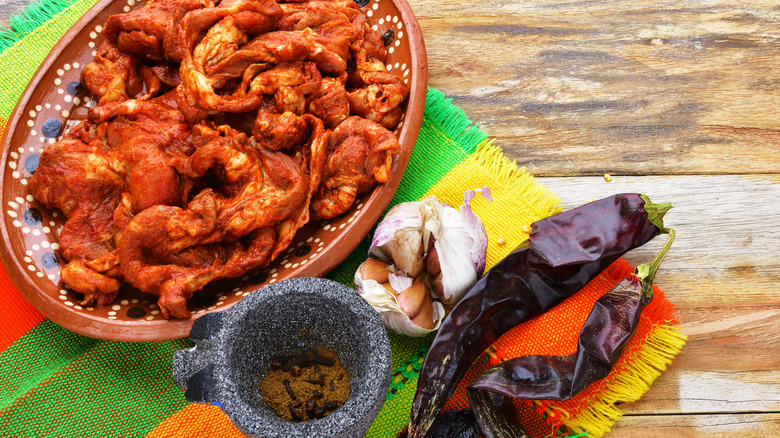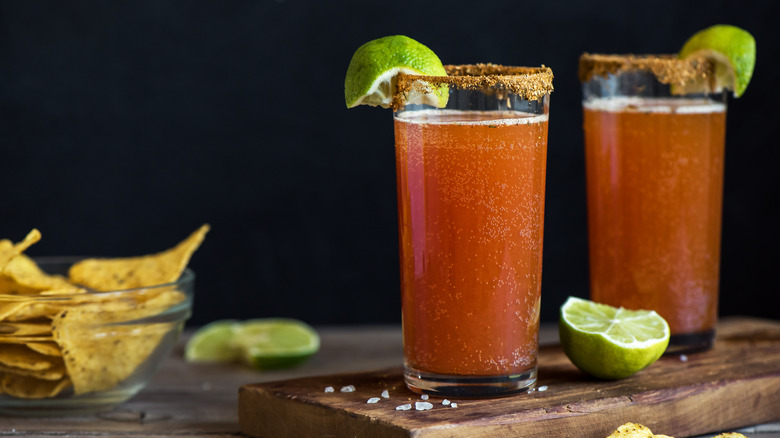What Is Chicken Al Pastor And What Does It Taste Like?
From upscale restaurants to roadside food trucks, chicken al pastor is a familiar dish at Mexican eateries. Whether served in a warm taco, sandwiched between melted cheese in a crispy quesadilla, or the main attraction in a hearty rice bowl, the sweet-and-savory dish doesn't disappoint. "Al pastor" refers to the cooking method, which translates in English to "in the style of the shepherd." It is typically made with pork, but the recipe has been adapted for leaner proteins like chicken or vegetarian versions, which are becoming increasingly popular.
Traditionally, boneless, marinated meat is placed on a vertical, rotating spit called a trompo. As the protein rotates, it cooks over direct high heat, causing the exterior to cook quickly and become crispy while the interior slowly cooks. An onion or pineapple is skewered on the top so that as the pineapple releases its juices and the fat renders, they drip down the meat, basting it and keeping it tender.
Taqueros, wielding long carving knives, shave thin slices of the crispy outer layer onto soft corn tortillas topped with diced pineapple, onion, and cilantro. While contemporary al pastor recipes, adjusted for the home cook, use different cooking methods and proteins, the marinade's aromatic flavor profile remains constant. Chicken al pastor marinates for hours in an adobo sauce made with dried chiles, garlic, achiote paste, pineapple juice, and spices like cumin, leaving the meat with its signature red color.
The history of al pastor
Al pastor is a delicious example of two cultures blending to create something exceptional. Although it's associated with Mexican cuisine, al pastor's roots are tied to the Middle East, where citizens of Turkey enjoyed spit-roasted lamb, or shawarma, centuries earlier. The Lebanese merchants who immigrated to Puebla, Mexico introduced the cooking technique in the 1930s. Despite being used by many cultures throughout Asia and Europe, by the 1960s, al pastor became a classic Mexican dish.
The Lebanese merchants were called "shepherds" or "pastors" in Spanish, acknowledging the dish's origin in its name but using the spices and tropical flavors unique to Mexico to claim it. Although the two cultures used vertical rotisseries to cook the upside-down, bell-shaped, boneless meat, they traditionally used different proteins and seasonings distinctive to their regions. Shawarma is heavily seasoned with dried spices like coriander, turmeric, black pepper, and sumac. Like a Greek gyro, which predates al pastor, it's served in a pita alongside hummus, pickled vegetables, and grains. Meanwhile, chicken al pastor is marinated in chilis and often topped with sweet pineapple.
Interestingly, al pastor isn't the only Mexican classic to come out of Puebla, Mexico. The country's culinary destination invented a popular street food, chalupas, enjoyed on Cinco de Mayo to mark the anniversary of the Mexican Army's victory over France at the Battle of Puebla in 1862.
Tips on how to prepare chicken al pastor at home
Most kitchens don't have a vertical spit, but the recipe for chicken al pastor can easily be adapted for home cooks. Fortunately, anyone can make the marinade with a blender, and the chicken can be grilled, sauteed, or broiled to achieve the signature char. Ultimately, you can use any type of boneless chicken. However, thighs are recommended since they are fattier and won't dry out like white meat.
To grill chicken al pastor, preheat the grill to medium heat while the chicken gets to room temperature. Use paper towels to remove the excess marinade and dry the chicken's surface so it can brown. Grill the meat for roughly 20 minutes, flipping halfway through cooking until it develops a char. Allow the meat to rest before slicing. When cooking the dish in a skillet, cut the raw chicken into strips before marinating and saute it over high heat. To slice the chicken thin, place it in the freezer for 15 minutes before cutting.
To prepare chicken al pastor in the broiler, set a lightly greased wire rack inside a rimmed baking sheet lined with foil. Avoid using parchment paper, which could ignite since it's heat resistant to 425 degrees Fahrenheit, and boilers can reach 500 degrees Fahrenheit. If you don't have foil, still make the dish, but be prepared to scrub the pan afterward. Spread the chicken thighs on the rack and broil the chicken until charred and cooked through, roughly 15 minutes.
Tips for making the al pastor marinade
As mentioned, the marinade unifies the different al pastor recipes, regardless of which protein or cooking method is used. Unlike a typical marinade, which only flavors the meat's surface, al pastor's is more like a brine, penetrating the protein and changing its structure. It tenderizes even tough cuts of meat and keeps it moist despite cooking at high temperatures. It's essential that the chicken is allowed to marinate for several hours to give it time to penetrate deeper. While you can't tell when the meat is raw if the marinade contains the proper ratio of liquid, acid, and salt, it will be evident when you carve the cooked meat, which should be juicy and stay intact. If the protein is dry and crumbly, it's time to find another recipe.
To get the most flavor from the marinade, keep a few things in mind. It may seem like an oxymoron but use fresh, dried chilis, which should be soft and pliable. If the chili is crumbling, toss it because its flavor will be muted. If you have trouble finding some of the chilis or achiote paste, you can use a few chipotle peppers in adobo sauce, delivering the same deep red color and heat. Before pureeing all the ingredients, toast the chilis and aromatics in oil to awaken them. It doesn't matter if you are using whole spices or powdered. This step will make the dish more flavorful.
A vegetarian al pastor variation to try
Most al pastor recipes contain a meat protein, but the same marinade can be used on tofu, plant-based meats, and vegetables, like our recipe for cauliflower al pastor. This vegetarian option cooks like a steak and is high in vitamins, minerals, and fiber. It's coated in the same flavorful marinade and slowly roasted in the oven until tender and sweet. The florets are used to make tacos layered with flavor and texture, including a habanero crema, pink pickled onions, ancho chili oil, radishes, and sweet pineapple. The recipe is versatile and can also be made with mushrooms, squash, eggplant, or a combination of veggies.
When you are ready to serve your delicious dish (or while preparing it), mix yourself a michelada, which goes perfectly with tacos al pastor. Pour your favorite Mexican-style beer like Dos Equis lager or Pacifico into a tall glass with ice rimmed with a cayenne pepper spiked salt. Add lime juice, soy sauce, Worcestershire sauce, and hot sauce and enjoy. If beer isn't your thing, we asked wine expert Catherine Fallis, Master Sommelier at Planet Grape, to recommend a few wine pairings for our taco recipes. Fallis' suggestions balance meaty Mexican dishes with citrusy wines that seem as natural as ordering your usual margarita.

